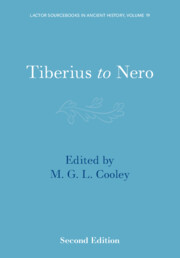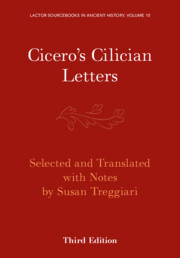Refine search
Actions for selected content:
23989 results in Ancient history
Frontmatter
-
- Book:
- Tiberius to Nero
- Published online:
- 30 August 2023
- Print publication:
- 31 August 2023, pp i-iv
-
- Chapter
- Export citation
Chapter 1 - The Ancient City
-
- Book:
- The Rise of Early Rome
- Published online:
- 17 August 2023
- Print publication:
- 31 August 2023, pp 8-28
-
- Chapter
- Export citation
Section L - RELIGION and IMPERIAL CULT
-
- Book:
- Tiberius to Nero
- Published online:
- 30 August 2023
- Print publication:
- 31 August 2023, pp 219-239
-
- Chapter
- Export citation
Section P - CONSPIRACIES, REVOLTS and SCANDALS
-
- Book:
- Tiberius to Nero
- Published online:
- 30 August 2023
- Print publication:
- 31 August 2023, pp 311-342
-
- Chapter
- Export citation
Section C - VELLEIUS PATERCULUS, History of Rome, 2.124- 131
-
- Book:
- Tiberius to Nero
- Published online:
- 30 August 2023
- Print publication:
- 31 August 2023, pp 59-69
-
- Chapter
- Export citation
Section U - UPPER CLASSES
-
- Book:
- Tiberius to Nero
- Published online:
- 30 August 2023
- Print publication:
- 31 August 2023, pp 401-415
-
- Chapter
- Export citation
Notes on Literary Sources
-
- Book:
- Tiberius to Nero
- Published online:
- 30 August 2023
- Print publication:
- 31 August 2023, pp 10-13
-
- Chapter
- Export citation
Contents
-
- Book:
- Tiberius to Nero
- Published online:
- 30 August 2023
- Print publication:
- 31 August 2023, pp 3-6
-
- Chapter
- Export citation
Acknowledgements
-
- Book:
- The Rise of Early Rome
- Published online:
- 17 August 2023
- Print publication:
- 31 August 2023, pp xvii-xviii
-
- Chapter
- Export citation
Chapter 2 - Transportation Infrastructures
-
- Book:
- The Rise of Early Rome
- Published online:
- 17 August 2023
- Print publication:
- 31 August 2023, pp 29-45
-
- Chapter
- Export citation
Section A - THE ACTS of the ARVAL BROTHERS (as preserved for AD 15 - 66)
-
- Book:
- Tiberius to Nero
- Published online:
- 30 August 2023
- Print publication:
- 31 August 2023, pp 21-42
-
- Chapter
- Export citation
Notes
-
- Book:
- The Rise of Early Rome
- Published online:
- 17 August 2023
- Print publication:
- 31 August 2023, pp 209-226
-
- Chapter
- Export citation
Index
-
- Book:
- The Rise of Early Rome
- Published online:
- 17 August 2023
- Print publication:
- 31 August 2023, pp 259-268
-
- Chapter
- Export citation
Index of Themes
-
- Book:
- Tiberius to Nero
- Published online:
- 30 August 2023
- Print publication:
- 31 August 2023, pp 440-444
-
- Chapter
- Export citation

Tiberius to Nero
-
- Published online:
- 30 August 2023
- Print publication:
- 31 August 2023

The High Tide of Empire
- Emperors and Empire AD 14–117
-
- Published online:
- 26 August 2023
- Print publication:
- 19 October 2023

Cicero's Cilician Letters
-
- Published online:
- 25 August 2023
- Print publication:
- 21 September 2023

Inscriptions of the Roman Empire, AD 14–117
-
- Published online:
- 24 August 2023
- Print publication:
- 07 September 2023
Contents
-
- Book:
- The Cambridge History of Ancient Christianity
- Published online:
- 23 August 2023
- Print publication:
- 24 August 2023, pp v-viii
-
- Chapter
- Export citation
23 - Office, and Appointment to Office, in Early Christian Circles
- from Part V - Contested Beliefs
-
-
- Book:
- The Cambridge History of Ancient Christianity
- Published online:
- 23 August 2023
- Print publication:
- 24 August 2023, pp 536-558
-
- Chapter
- Export citation
